
In the ever-evolving and competitive landscape of B2B sales, generating leads is not enough. Knowing how to nurture B2B leads effectively can make all the difference between stagnation and success. To maximize conversions and drive revenue, businesses must master the art of B2B lead nurturing.
Lead nurturing is a pivotal strategy that can significantly impact your conversion rates and drive business growth. But, the question often arises: "How to nurture B2B leads?" This blog entry will explore the art and science of mastering this strategy. We'll explore strategies, share best practices, and provide actionable insights to optimize your lead-nurturing efforts.
Whether you're a seasoned marketer or just starting in the B2B arena, our comprehensive guide will equip you with the knowledge and tools to excel in this critical aspect of your marketing strategy.
What is B2B Lead Nurturing?
B2B lead nurturing is the process of building relationships with potential customers and guiding them through the buyer's journey until they are ready to make a purchase. Dive deeper to explore its role in the sales funnel and take actionable insights to achieve optimal conversions and revenue growth for your business.
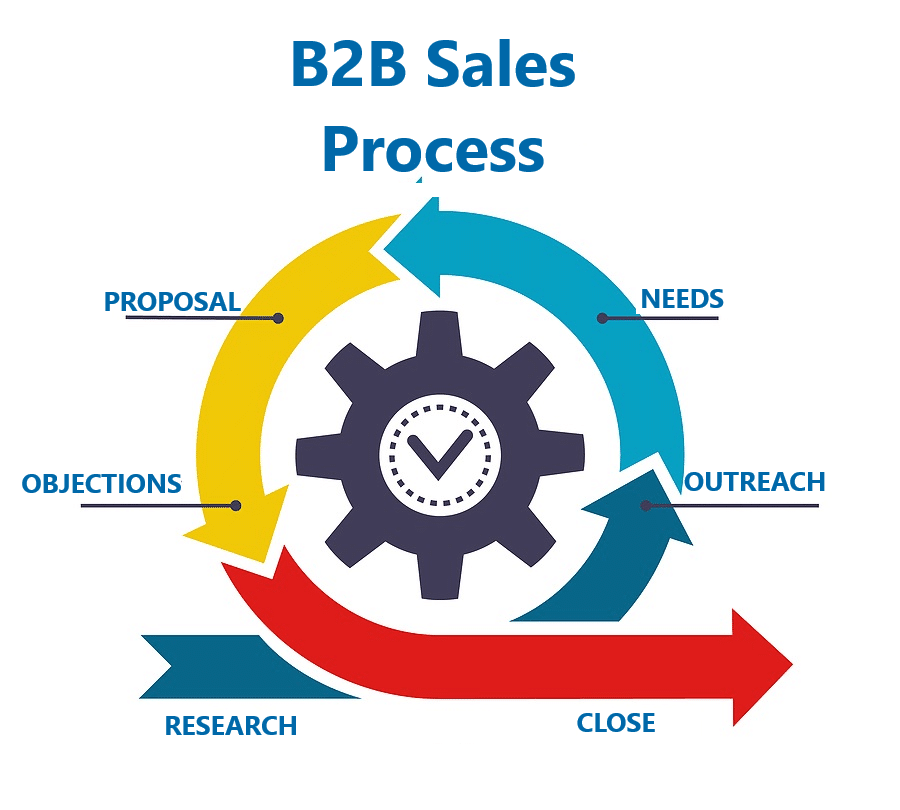
Image source: Sales Higher
As we’re into 2023, businesses face new challenges and opportunities in driving sales success. Based on research conducted by Forrester, companies that excel in lead nurturing manage to generate 50% more sales-ready leads, all while reducing costs by an impressive 33%. That's why understanding the significance of the lead nurturing process and employing the right strategies is crucial.
Understanding the Importance of B2B Lead Nurturing
Before diving into strategies and best practices, it's essential to understand what lead nurturing entails and why it matters more than ever in 2023.
Lead nurturing refers to building relationships with potential customers at every stage of their buying journey. It involves delivering relevant content and personalized interactions to guide prospects toward making a purchase decision. In 2023, this approach has gained unprecedented significance due to the increasingly competitive and digitalized B2B landscape.
Lead nurturing is crucial for several reasons. It's the secret sauce that separates successful businesses from the rest. Here's why it's not something you can afford to overlook:
1. Establishing Trust And Credibility With Business Prospects
By providing valuable and relevant information at each stage of the buyer's journey, businesses can position themselves as industry leaders and build strong relationships with potential customers.
Imagine being seen as the go-to expert in your industry, someone whose insights and solutions are trusted without question. That's what happens when you provide valuable and tailored information at every step of your potential customer's journey. It's not just about selling; it's about building lasting relationships.
2. Staying Top-of-Mind With The Prospects
In a competitive market, it's easy for potential customers to forget about a business if they aren’t consistently engaged. Lead nurturing is your secret weapon to ensure that your business remains front and center in your prospects' minds. You'll ensure your brand is unforgettable by delivering content that's so personalized and engaging that it's impossible to ignore.
If you're out of sight, you're out of mind, and your competitors are more than happy to take your place.
3. Enabling Business To Optimize Conversion Rates
By guiding prospects through the buyer's journey and addressing their pain points and objections along the way, businesses can increase the likelihood of a successful conversion.
Think of it as your personal guide for prospects navigating the treacherous waters of decision-making. By addressing their concerns, objections, and needs every step of the way, you're essentially holding their hand through the process, making it more likely that they'll choose your solution when the time comes.
Don't underestimate the power of a lead nurturing strategy. Your key to trust, top-of-mind awareness, and, ultimately, conversions will set your business on the path to success.
Common Pain Points in Lead Nurturing
Lead nurturing, while essential, comes with its set of challenges. These include lead decay, lack of personalization, and difficulty maintaining consistent engagement. To highlight the impact of these challenges, let's explore real-world scenarios.
Challenge 1: Lead Decay - The Slow Fade
Consider a scenario where a potential lead shows initial interest in your product or service but gradually loses interest due to a lack of follow-up or relevant communication. This is a classic example of lead decay, a common pain point that can be detrimental to conversions.
Challenge 2: Lack of Personalization - The One-Size-Fits-None Approach
Imagine sending generic, one-size-fits-all content to your leads. This approach fails to resonate with individual needs and preferences, leading to disengagement and lost opportunities.
It's not just about recognizing the obstacles but finding effective B2B lead nurture solutions to ensure your nurturing process remains robust and productive.
Challenge 3: Lack of Alignment Between Marketing and Sales Teams
Imagine a bustling corporate office where the marketing and sales teams are like two dancers on a busy dance floor. The marketing team is responsible for attracting and getting leads interested, while the sales team is eager to swoop in and convert these leads into loyal customers.
However, in this scenario, there's a clear lack of coordination between these two teams. The marketing team is busy generating leads, but the sales team often finds that these leads aren't quite ready to take the plunge. There's frustration on both sides as leads get lost in the shuffle, and opportunities slip through the cracks. This challenge highlights the critical need for alignment between marketing and sales teams to ensure that leads are nurtured effectively and handed off to the sales team at the right moment.
Challenge 4: The Long-Term Commitment
Now, let's shift our focus to a business with ambitious goals. They've embraced lead nurturing with gusto and launched their campaigns enthusiastically. However, as the months pass, they start to wonder why they haven't seen the dramatic results they hoped for.
The challenge here is that they've underestimated the long-term commitment that lead nurturing requires. It's not a sprint but a marathon, demanding consistent effort and a willingness to play the long game.
Lead nurturing demands a long-term perspective. It's not a quick fix but a continuous process requiring patience and persistence. Businesses must commit to nurturing leads over time to achieve the desired results.
B2B Lead Nurturing Tactics for Optimal Conversions
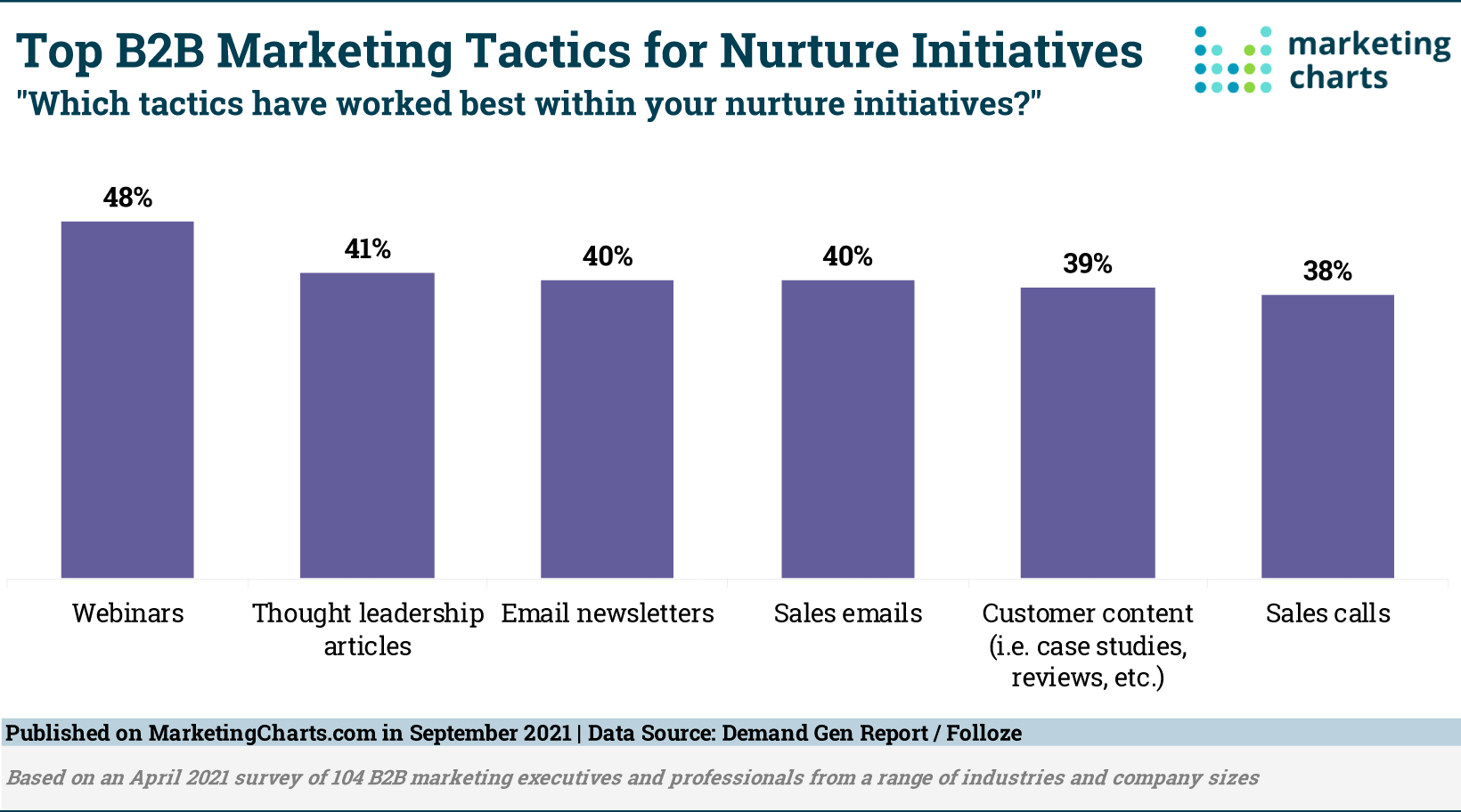
Image source: Marketing Charts
Businesses should employ a combination of tactics that are tailored to their target audience and business goals. Here are some effective strategies to employ:
1. Segmenting Leads
Segmenting leads based on behavior, demographics, and engagement is a fundamental step. It enables businesses to tailor their communication and content to specific audience groups, enhancing relevance and engagement.
2. Personalized Content
The power of personalized content cannot be overstated. By understanding individual lead interests and needs, businesses can create content that speaks directly to each prospect, increasing the chances of conversion.
3. Multi-Channel Engagement
Reaching leads through various channels such as email, social media, and webinars ensures a holistic approach. Different leads may prefer different channels, and utilizing them effectively broadens your reach.
4. Timely Follow-Up
Timely and relevant follow-ups are critical for maintaining engagement. Consistency in communication demonstrates commitment and keeps your brand top-of-mind for potential buyers.
Mapping Nurturing Content to Buyer's Journey
Understanding the buyer's journey is essential for effective lead nurturing. Businesses should create content that aligns with each stage of the journey - awareness, consideration, and decision. This ensures prospects receive the right information at the right time, helping move them closer to a purchase decision.
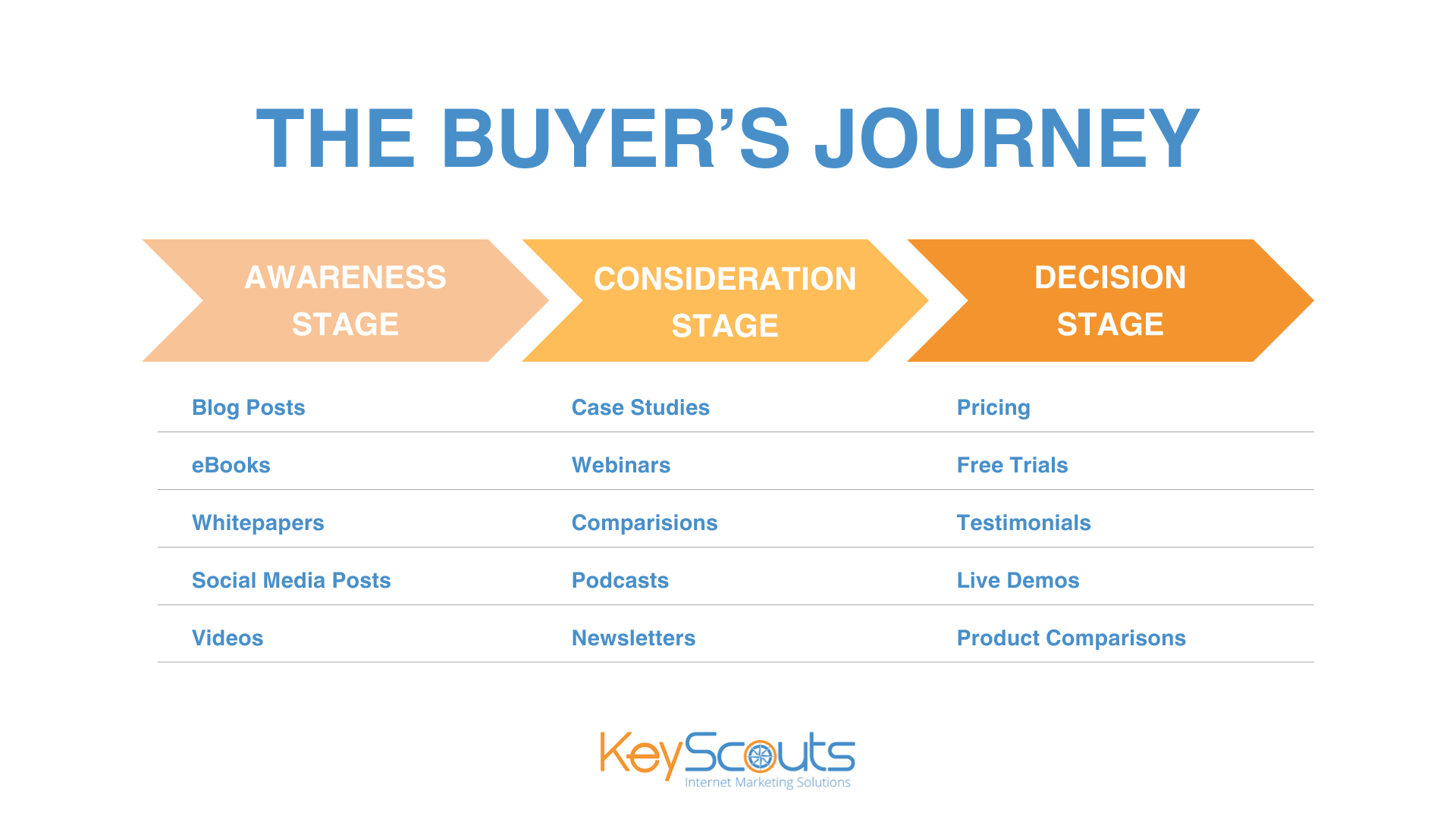
Awareness Stage: Provide educational content that addresses industry challenges and showcases your expertise without directly promoting your product. These could be blog posts, eBooks, and whitepapers to help prospects understand their pain points and explore potential solutions.
Consideration Stage: Offer content that explores solutions, including your product, in-depth. Case studies, webinars, and comparisons can be valuable here. Also, consider product demos to showcase your expertise and demonstrate the value of your solution.
Decision Stage: Present content that emphasizes the unique value of your product or service and facilitates the decision-making process. You can provide pricing information, testimonials, and free trials to help prospects make a final decision.
B2B Lead Nurturing Examples
Below, we've outlined a series of diverse B2B lead nurturing examples to showcase the multifaceted strategies that can guide potential clients along their conversion journey. These examples illustrate the power of personalization, informative content, and engagement in transforming prospects into loyal customers.
1. Personalized Email Campaigns: Sending tailored emails to leads based on their specific interests and behaviors can be highly effective. For instance, if a lead has shown interest in a particular product or service, you can send them targeted content or offers related to that interest.
2. Educational Webinars: Hosting webinars that provide valuable industry insights or demonstrate how your product or service can solve specific challenges can nurture leads by positioning your company as an authority in your field.
3. Drip Marketing Campaigns: Drip campaigns involve a series of automated emails sent to leads over time. These emails can gradually educate leads about your offerings, share success stories, and address common pain points.
4. Content Marketing: Creating and sharing informative blog posts, whitepapers, and case studies can help nurture leads by offering them valuable information and solutions. You can gate some of this content behind forms to capture lead information.
5. Social Media Engagement: Actively engaging with your leads on social media platforms can keep your brand top of mind. Respond to comments, share relevant content, and initiate conversations to nurture leads.
6. Personalized Landing Pages: Designing landing pages that dynamically change based on a lead's previous interactions can provide a tailored experience. For example, showing different content or offers to leads who have visited your website multiple times versus first-time visitors.
7. Lead Scoring and Segmentation: Use lead scoring to identify the most engaged and sales-ready leads. Segment your leads based on their behavior and demographics, and then tailor your nurturing efforts accordingly.
8. Re-Engagement Campaigns: Sometimes, leads may go dormant. Sending re-engagement emails with special offers or reminders of your product or service's value can bring these leads back into the nurturing process.
9. Customer Success Stories: Sharing success stories or case studies of satisfied customers can instill confidence in your leads. These examples show how your offerings have positively impacted others in similar situations.
10. Personalized Follow-ups: Following up with personalized messages or calls can nurture leads by showing genuine interest in their needs and concerns after initial contact.
Remember that the effective process of lead nurturing involves a combination of these strategies customized to your specific industry, target audience, and business goals.
Creating a Customer Nurturing Strategy
Lead nurturing doesn't end once a prospect becomes a customer. In fact, nurturing existing customers is just as important as nurturing leads. By providing ongoing value and support, businesses can increase customer satisfaction, drive repeat purchases, and foster long-term loyalty.
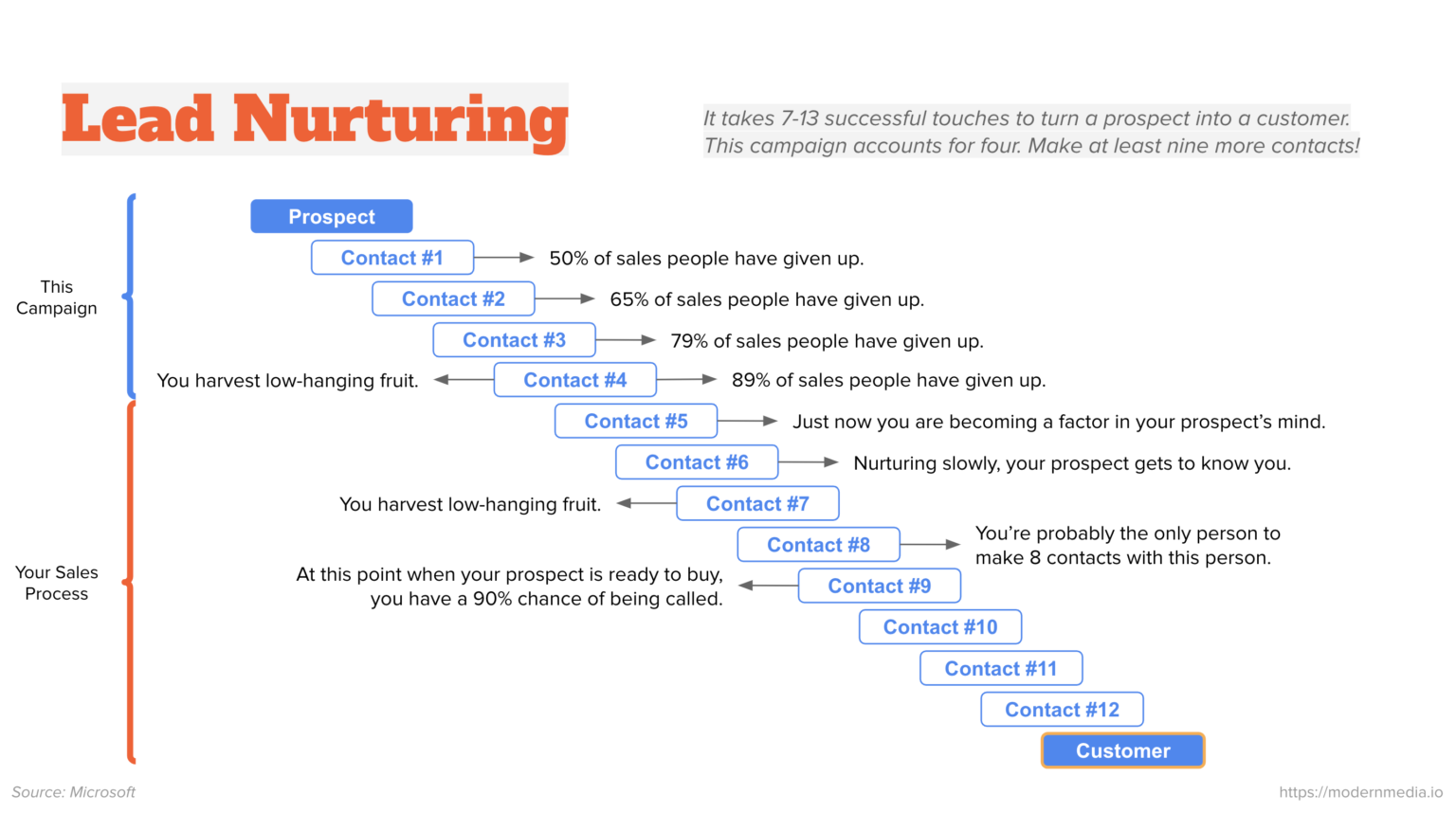
To create an effective customer nurturing strategy, businesses should deliver personalized and relevant content, provide exceptional customer service, and proactively address any issues or concerns. By continuously nurturing their existing customers, companies can turn them into brand advocates who will continue to purchase and refer new customers.
Scaling Nurturing Efforts
As a business grows, it becomes increasingly important to scale lead nurturing efforts. This can be achieved through automation and technology solutions that streamline the process and make it more efficient.
Various tools and solutions are available to help businesses scale their lead nurturing efforts. These include marketing automation platforms, customer relationship management (CRM) systems, and email marketing software. These tools can automate repetitive tasks, track and analyze data, and enable businesses to deliver personalized content at scale.
By leveraging these tools, businesses can increase their efficiency, reach a larger audience, and achieve better results with their lead nurturing campaigns.
Marketing automation plays a pivotal role in streamlining and optimizing lead nurturing efforts. It allows for automated responses, lead scoring, and personalized communication at scale. Popular marketing automation and B2B lead nurturing tools like HubSpot, Marketo, and Pardot offer features that help businesses manage and nurture leads effectively.
Overcoming Long Sales Cycles with Nurturing
Lead nurturing is crucial in overcoming the challenges of lengthy and complex sales cycles.
By nurturing leads over an extended period, businesses can keep prospects engaged and informed, ensuring they remain interested in their solution. This is particularly important when dealing with complex products or services that require significant time and resources.
Lead nurturing helps businesses build trust and credibility with prospects, address their concerns and objections, and provide ongoing support and education. By doing so, companies can shorten sales cycles, increase conversion rates, and drive revenue.
Tracking and Measuring B2B Lead Nurturing Success
Monitoring the success of lead nurturing efforts is essential to identify what is working and what needs improvement. Businesses should track several key metrics to evaluate the effectiveness of their lead nurturing campaigns.
Some essential metrics include conversion rates, engagement rates, lead velocity, and revenue generated. By regularly monitoring these metrics, businesses can gain insights into the performance of their lead nurturing efforts and make informed decisions to optimize their campaigns.
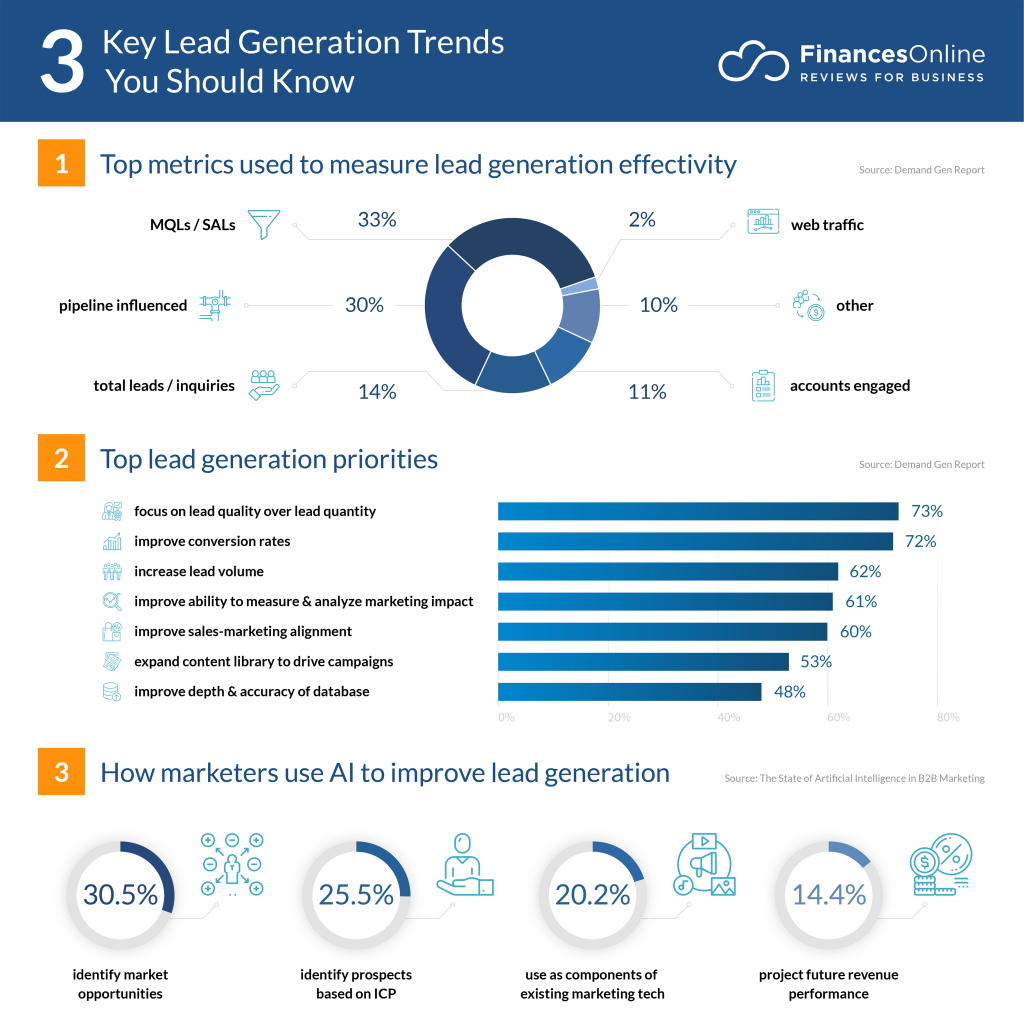
Image source: FinancesOnline
Additionally, businesses should conduct A/B testing to experiment with different approaches and identify the most effective strategies. Companies can continually improve their results and drive better conversions by testing and tweaking various elements of their lead nurture campaigns.
Balancing Quantity and Quality
As businesses grow, scaling lead nurturing efforts can be challenging. However, it's possible to manage larger lead databases without sacrificing personalization. Address the challenges and solutions for scaling lead nurturing while maintaining quality.
Implementing a Successful B2B Lead Nurture Campaign
Based on the above insights, businesses should follow a systematic approach to implement a successful B2B lead nurture campaign. Here are some key steps to consider:
1. Define your target audience: Understand your ideal customers and create buyer personas representing them.
2. Develop your nurturing content: Create valuable and relevant content that aligns with each stage of the buyer's journey.
3. Automate your nurturing process: Leverage marketing automation tools to deliver personalized content at scale and track prospect engagement.
4. Measure and analyze results: Continuously monitor and analyze the performance of your lead nurture campaign to identify areas for improvement.
5. Iterate and optimize: Use the insights gained from your analysis to make data-driven decisions and optimize your lead nurturing efforts.
Following these steps, companies can build an effective lead nurture campaign that drives optimal conversions and generates revenue.
Conclusion: The Future of B2B Lead Nurturing
B2B lead nurturing is the cornerstone of achieving sales success in 2023 and beyond. By understanding the importance of lead nurturing, addressing common pain points, and implementing effective strategies and best practices, businesses can build strong relationships with their prospects, maximize conversions, and achieve long-term success.
As technology continues to evolve, the future of B2B leads nurturing lies in automation, personalization, and data-driven decision-making. With the advent of artificial intelligence and machine learning, businesses can analyze vast amounts of customer data to identify patterns and trends. This will allow them to anticipate customer needs and deliver personalized experiences at scale.
We will also see a greater emphasis on omnichannel marketing. Businesses will need to meet customers where they are, whether it's through email, social media, or even chatbots. The key is to provide a seamless and integrated experience across all touchpoints. With the rise of mobile and social media usage, businesses can leverage these platforms to engage with customers in real time and build meaningful connections.
Businesses that embrace these trends and leverage the right tools and solutions will be well-positioned to stay ahead of the competition and drive optimal results.
Remember, continuous learning, adaptation, and optimization are the keys to mastering lead nurturing. Start implementing these strategies today and set yourself on the path to elevated sales outcomes in the dynamic B2B landscape of 2023.
Looking for effective B2B nurturing tactics? Contact KeyScouts today!





